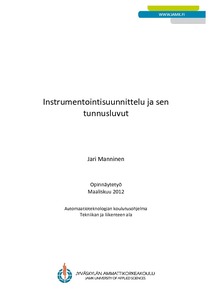| dc.contributor.author | Manninen, Jari | |
| dc.date.accessioned | 2012-06-08T10:09:37Z | |
| dc.date.available | 2012-06-08T10:09:37Z | |
| dc.date.issued | 2012 | |
| dc.identifier.uri | URN:NBN:fi:amk-2012060812271 | |
| dc.identifier.uri | http://www.theseus.fi/handle/10024/46714 | |
| dc.description.abstract | Työn tarkoitus oli parantaa ja kehittää instrumentointisuunnitteluun kuluvan työajan arviointia.
Aluksi työssä käsiteltiin instrumentointiin liittyviä aiheita. Näitä olivat instrumentoinnin kenttäväylät, standardit ja Ex-alueen vaatimuksia. Työssä vertailtiin myös perinteisen 4…20 mA ja kenttäväylätekniikalla toteutetun suunnittelun eroavaisuuksia aikataulun, tilatarpeen ja kenttälaitteiden osalta.
Työssä analysoitiin toimeksiantajan 2000-luvulla toteutetut instrumentoinnin suunnitteluprojektit ja määritettiin instrumentointisuunnittelua kuvaavat tunnusluvut. Lopuksi työssä pohdittiin niitä tekijöitä, joilla pystytään vaikuttamaan instrumentointisuunnittelun tehokkuuteen ja samalla laadukkaaseen suunnitteluun.
Instrumentointisuunnittelun laatuun ja tehokkuuteen voidaan parhaiten vaikuttaa kiinnittämällä huomiota suunnitteluvälineisiin, lähtötietojen ja muutoksien hallintaan sekä suunnittelun projektointiin mutta ennen kaikkea suunnittelijoiden osaamiseen ja motivaatioon. | fi |
| dc.description.abstract | The purpose of the thesis was to improve and develop the estimation of the time needed for instrumentation engineering.
In the beginning of the thesis different fieldbuses are discussed. Profibus PA and Fieldbus Foundation are analyzed in more details. These are in the IEC 651158 standard of the process automation fieldbus. The thesis compares the design of a field bus and traditional 4 – 20 mA engineering. The focus was on the schedule, space requirements, purchase of the field devices and cabling. After that there are discussed some standards of the instrumentation and instrumentation engineering of explosive atmospheres, ATEX.
In the thesis the assigning company’s projects of the engineering of instrumentation in the 21st century were analyzed. After that the key figures of instrumentation engineering were defined. The final part of the thesis discusses the functions of the quality assurance that can be carried out with better quality in the projects of instrumentation engineering.
The quality and effectiveness could be improved with the better implementation of engineering and the management of initial data and changes. However, the best functions that can be carried out with better quality in the projects of instrumentation engineering are improved instrument designer knowledge and motivation. | en |
| dc.language.iso | fin | |
| dc.publisher | Jyväskylän ammattikorkeakoulu | |
| dc.rights | All rights reserved | |
| dc.title | INSTRUMENTOINTISUUNNITTELU JA SEN TUNNUSLUVUT | fi |
| dc.type.ontasot | fi=Ylempi AMK-opinnäytetyö|sv=Högre YH-examensarbete|en=Master's thesis| | |
| dc.identifier.dscollection | 10024/361 | |
| dc.organization | Jyväskylän ammattikorkeakoulu | |
| dc.contributor.organization | Jyväskylän ammattikorkeakoulu | |
| dc.subject.keyword | Instrumentointi | |
| dc.subject.keyword | kenttäväylät | |
| dc.subject.keyword | standardit | |
| dc.subject.keyword | Ex | |
| dc.subject.keyword | Atex | |
| dc.subject.keyword | instrumentointisuunnittelu | |
| dc.subject.degreeprogram | fi=Automaatiotekniikka|sv=Automationsteknik|en=Automation Engineering| | |
| dc.subject.discipline | Automaatioteknologian koulutusohjelma (Ylempi AMK) | |
